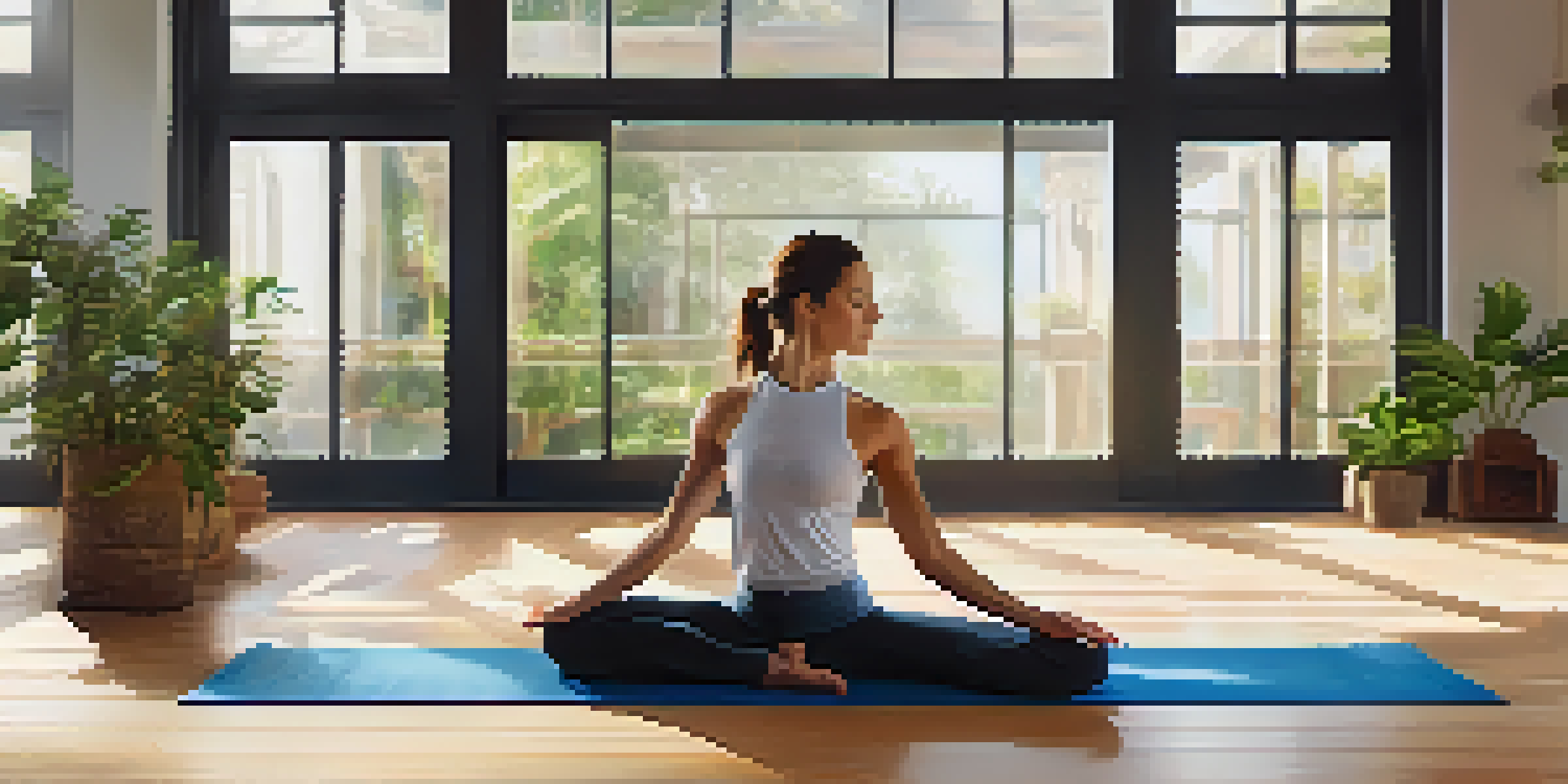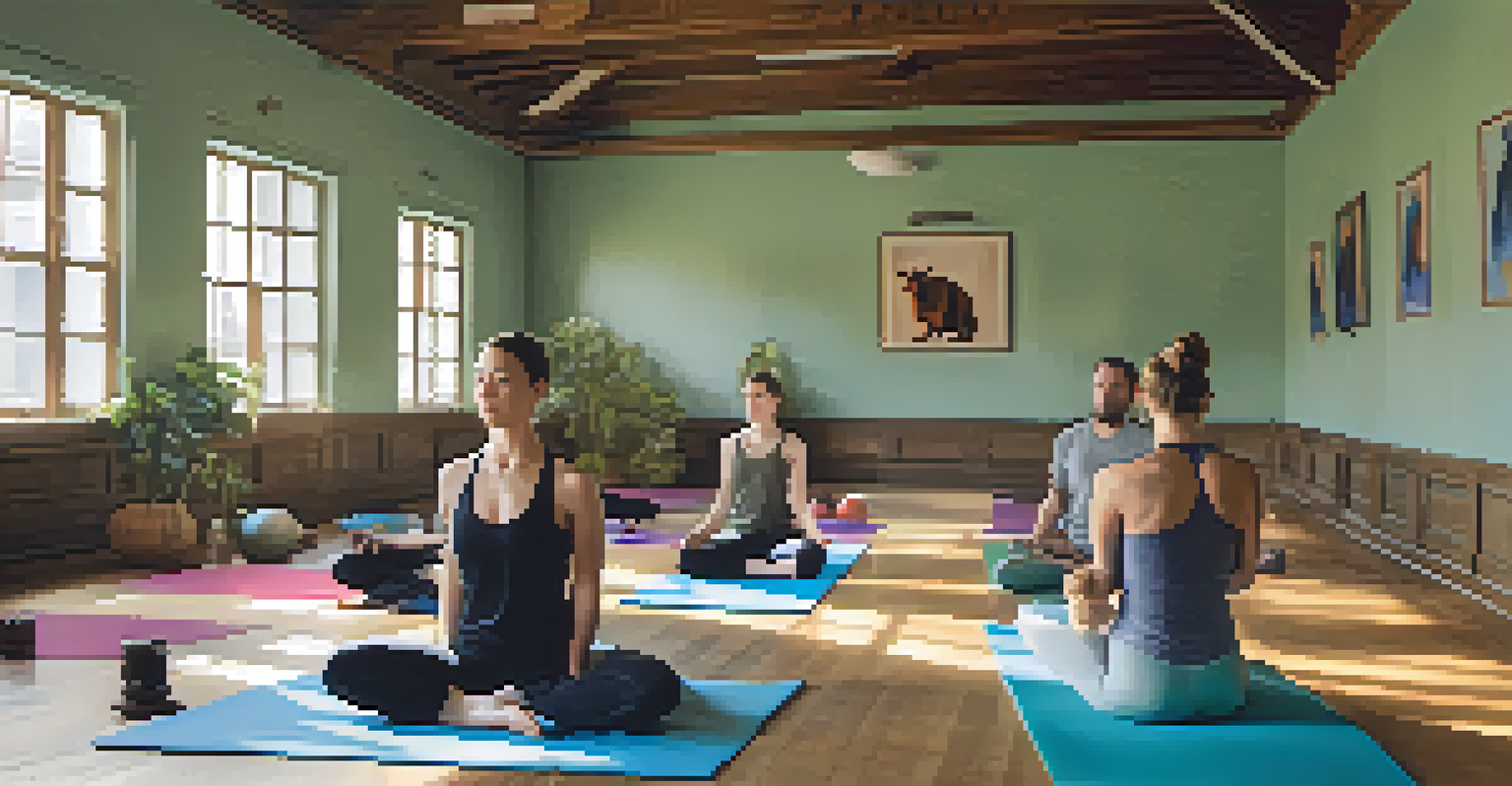10 Yoga Poses for a Comprehensive Flexibility Routine

Understanding the Importance of Flexibility in Yoga
Flexibility is a key component of overall fitness and wellness. When your muscles and joints are flexible, you not only improve your range of motion but also reduce the risk of injuries. In yoga, flexibility allows for deeper stretches and better alignment, enhancing the benefits of each pose.
Flexibility is not just about being able to touch your toes; it's about being able to adapt to life's challenges with grace.
Moreover, flexibility contributes to better posture, which can alleviate tension in your body. Think of it as oiling the hinges of a door; the smoother they move, the better the door functions. This is similar to how flexible muscles can support overall body mechanics and function more efficiently.
Integrating flexibility into your routine can also lead to a more mindful practice. As you learn to listen to your body and respect its limits, you'll cultivate patience and awareness, both on and off the mat.
1. Downward Facing Dog for Overall Flexibility
Downward Facing Dog is a foundational pose that beautifully stretches the entire body. It targets the hamstrings, calves, and spine, making it a fantastic way to warm up and prepare your muscles. Picture yourself as an upside-down 'V'—this shape encourages lengthening and opening up tight areas.

As you hold this pose, focus on pressing your heels toward the ground, which enhances the stretch in your legs. Breathe deeply and feel the elongation of your spine as you draw your shoulders away from your ears. This pose not only improves flexibility but also energizes your body, setting a positive tone for your practice.
Flexibility Enhances Overall Wellness
Improving flexibility in yoga not only boosts your range of motion but also reduces injury risks and promotes better body mechanics.
To maximize the benefits, try pedaling your feet or swaying your hips gently. This dynamic movement can help release any lingering tension, allowing for a more relaxed experience.
2. Cat-Cow Stretch for Spinal Flexibility
The Cat-Cow Stretch is a gentle way to warm up your spine and improve its flexibility. Transitioning between these two positions helps to increase mobility in the back while also relieving tension. Imagine your spine as a ribbon, gently undulating as you move between the two poses.
The body is a sacred garment. It is your first and last garment. It is what you enter life in and what you depart life with, and it should be treated with honor.
Start on your hands and knees, inhale to arch your back (Cow), and exhale to round it (Cat). This rhythmic movement not only stretches the spine but also opens up the chest and shoulders, which can become tight from daily activities. It’s a wonderful way to release stress and cultivate a sense of calm.
Incorporating this stretch into your routine can also enhance your overall posture. The more flexible your spine, the easier it is to maintain an upright position throughout the day.
3. Forward Fold for Hamstring Flexibility
The Forward Fold is a staple pose that significantly stretches the hamstrings and lower back. As you bend forward, think of it as a gentle release—allowing your body to let go of tightness and stress. Picture your body as a rag doll, fully relaxed and hanging down toward the ground.
To perform this pose, stand with your feet hip-distance apart and hinge at your hips, keeping your knees slightly bent if needed. Allow your head and neck to relax, and breathe deeply, feeling the stretch in your hamstrings. This pose not only increases flexibility but also calms the mind, making it a great addition to any routine.
Key Poses for Flexibility Training
Incorporating poses like Downward Facing Dog and Pigeon Pose can significantly enhance flexibility, targeting specific muscle groups effectively.
To deepen the stretch, try clasping opposite elbows and gently swaying side to side. This added movement can provide a soothing release, enhancing the benefits of the Forward Fold.
4. Lizard Pose for Hip Flexibility
Lizard Pose is an excellent choice for opening the hips and increasing flexibility in the groin area. This pose may feel challenging at first, but it’s incredibly rewarding as it allows for deeper stretches. Imagine your body sinking closer to the ground, releasing any pent-up tension in your hips.
Start in a low lunge position with one foot forward, and then lower your hands to the inside of your front foot. Hold this pose, and focus on relaxing into the stretch. Breathing deeply can help deepen the stretch, allowing you to feel more comfortable as you explore your range of motion.
For an added challenge, try lowering your forearms to the ground. This modification can intensify the stretch and help you achieve greater flexibility over time.
5. Pigeon Pose for Deep Hip Opening
Pigeon Pose is a powerful pose for targeting the hips and glutes, promoting flexibility in these often-tight areas. It’s like giving your hips a deep massage, releasing the tension that builds up from sitting or physical activity. Visualize your body melting into the mat as you breathe and relax.
To get into Pigeon Pose, start in a tabletop position and bring one knee forward while extending the opposite leg back. Keep your hips square to the ground, and focus on lengthening your spine. This pose not only enhances flexibility but also creates space in the hips, fostering a sense of freedom.
Mindfulness Through Stretching
Practicing flexibility in yoga encourages mindfulness, helping you listen to your body and cultivate patience both on and off the mat.
As you hold the pose, you can lean forward to deepen the stretch. This added layer of depth can help you release any remaining tightness, making it a favorite for many yoga practitioners.
6. Cobra Pose for Spine and Chest Flexibility
Cobra Pose is a fantastic way to stretch and strengthen your spine while also opening up the chest. This pose encourages flexibility in your back and can counteract the effects of slouching from daily activities. Visualize your heart lifting toward the sky as you engage your back muscles.
To practice Cobra, lie on your stomach and place your hands under your shoulders. As you inhale, lift your chest off the ground, keeping your elbows slightly bent. This gentle backbend stretches the spine and opens the chest, promoting better posture and alignment.

If you want to intensify the stretch, consider transitioning to Upward Facing Dog, where you lift your thighs off the ground. This variation can enhance the stretch and deepen your connection to your breath.
7. Butterfly Pose for Inner Thigh Flexibility
Butterfly Pose is a soothing stretch that targets the inner thighs and groin. It’s like allowing your body to open up like a flower, creating space and releasing tension. This pose is especially beneficial for those who spend long hours sitting.
To get into Butterfly Pose, sit on the mat and bring the soles of your feet together, allowing your knees to fall outward. Hold onto your feet and gently press your knees down toward the ground. This will help you feel the stretch in your inner thighs while promoting relaxation.
As you breathe deeply in this pose, try leaning forward slightly. This movement can deepen the stretch and enhance the overall experience, making it a great addition to your flexibility routine.
8. Seated Forward Bend for Full-Body Stretch
Seated Forward Bend is a fantastic way to stretch the entire back side of your body, from the heels to the head. It’s a calming and restorative pose that encourages deep relaxation while enhancing flexibility. Imagine stretching like a cat, elongating your spine with each breath.
To practice this pose, sit with your legs extended in front of you and reach for your feet, keeping your back straight. If you can't reach your toes, that’s perfectly fine—just grab your shins or thighs. The goal is to hinge at the hips and extend through the spine.
As you hold the pose, focus on your breath and allow your body to relax into the stretch. This will help you deepen the experience and improve your flexibility over time.